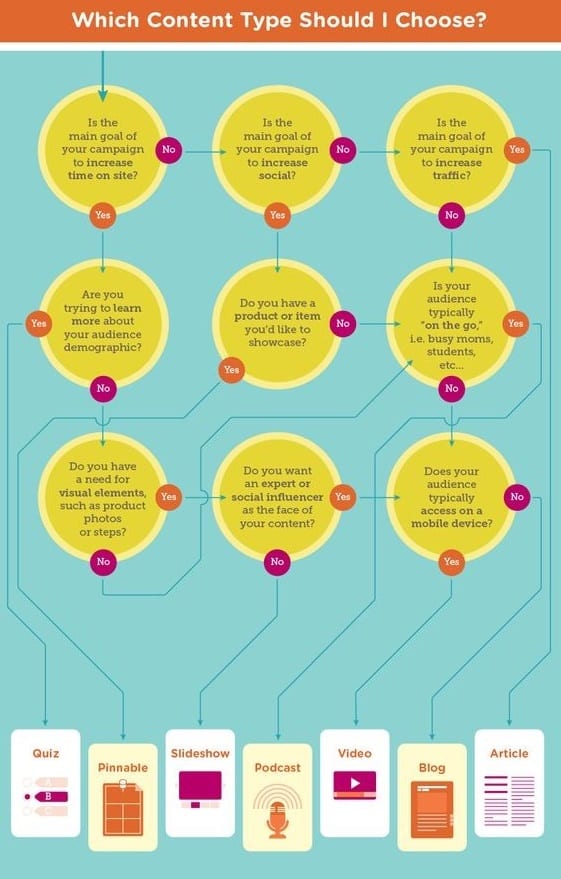-
Content Marketing
Content marketing has become the next big thing for brands and organizations who wish to elicit substantial response from their customers. It has become big and the bold in the year 2016 as more and more brands are recognizing the value of content marketing and its application across different media channels. A year ago, you could easily get away with fluff content and still get positive consumer responses, not today. Due to the advent of internet marketing, customers are constantly bombarded with advertisements that make it not only difficult but impossible to cut through the competition.
Here are 6 strategic steps that you need to take in order to develop a strong content marketing strategy to make sure that you stay one step ahead of your competition.
Step 1: Understand how content marketing works
You cannot begin without comprehending the very basics of the concept. Dictionary defines content marketing as:
“ A strategic approach towards marketing through creating and distributing valuable information to the target audience in order to garner positive response and long term customer engagement.”

Content marketing is mainly about 3 things:
- Defining the target audience
- Developing related content
- And identifying the right channels for the delivery of that content.
Peruse the following infographics to understand how content marketing actually works. In simple words, it is a marketing strategy that helps you materialize your organizational goals through transparent communication between you and your audience.

Step 2: Define your target market
Content marketing is a crucial component of any company’s overall marketing strategy. However, you can never really succeed in making your content marketing valuable until and unless you have a well defined audience. In this day and age, people have more information and less attention span. Research suggests that companies and brands, for that matter, who haphazardly give away content for the perusal of general audience merely see any results at the end.
Defining your target market narrows down your target for better reach. The better you know your audience, the closer you will be to achieving a successful response. However, defining your target audience is just the first step of the process; you have to understand your audience. Understanding what your audience likes, what they pay for, and what they are willing to pay for is extremely crucial when it comes to defining your overall content marketing strategy.
So, when you get down to defining your audience, make sure that you create consumer personas that perfectly highlight the main characteristics, including the buying habits, of your target customers. Once you understand who your customers are, what they want, and how to reach them you will find it easier to come up with a content plan that will serve your target audience’s needs while helping you garner ample sales.

Step 3: Devise customer-centric Content Formula
After you have identified your customers and their characteristics, you are one step closer to planning a content strategy that will actually work. Many brands and companies ignore the importance of creating customer-centric content. Before we roll the ball any further, let’s just understand what exactly customer-centric content is.
A customer-centric content is a content that is devised according to the interests of your target audience. Remember, in the last step we talked about creating consumer personas. These personas are actually a way to understand your audience better and eventually use them in devising a customer-centric content.
For example, if you are a manufacturer of beauty products, your customers must be people who have a deep interest in purchasing beauty products on a regular basis. Then, the most accurate content for your audience is the one related to beauty product reviews, beauty hacks, natural beauty treatments, and makeup tutorials.
Remember that your job is to educate your audience through genuine, informative content that helps them overcome everyday issues. Now you may ask why this content is important anyway. Well, content does more than just sharing information with your customers; it helps you gain their trust. If you share informative posts that actually help them solve an issue, your customers will always look up at you for advice. The whole purpose of developing customer-centric content is to gain trust and convert leads into sales.
Below is an infographic to help you understand different kinds of content. You can see what will work best for your site and utilize it to garner your target audience’s interest.

Step 4: Create Content calendar
If you have followed the first 3 steps as discussed above, you are on your way to get things started for your business. The next step is to organize your content and create a content or editorial calendar to establish regularity of the content that you will be posting on different social media networks. Below is an example of content management calendar.

Step 5: Infuse the Right SEO
Content alone cannot do wonders for your business’s online visibility. Only the content that is appropriately search engine optimized can help you garner the increased visibility that can bring more visitors and customers to your website. The following diagram shows the strategic steps that you need to take in terms of SEO to make sure that your content is viewed by your target audience.

Step 6: Measure results
The first 5 steps of the process will help you create engaging content for the target audience that is looking for the specific content. But the journey does not stop here; you have to keep rolling, making sure that there is always content that is driving traffic to your website. To measure your daily progress, you can utilize various web analytics tools, among which Google analytics is on the top, to measure and report results for a quick understanding of your customer reach.
Here are the most prominent and useful analytics tools, according to their usage, which you can utilize to measure results for better content productivity.

 When it comes to content marketing strategy, you have to be extremely meticulous. Each and every step of the process matters; each step essentially supplements the other steps. Therefore, it is extremely crucial that you take it step-by-step all through the end and repeat the process after measuring the results.
When it comes to content marketing strategy, you have to be extremely meticulous. Each and every step of the process matters; each step essentially supplements the other steps. Therefore, it is extremely crucial that you take it step-by-step all through the end and repeat the process after measuring the results.


